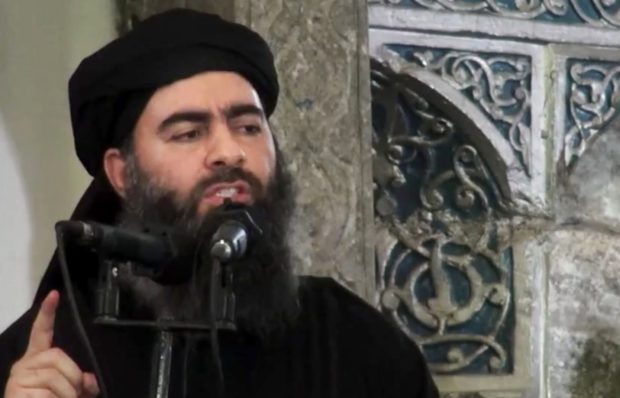
This is a file image of Islamic State leader Abu Bakr al-Baghdadi that was made from a video posted on a militant website last July 5, 2014. (AP File Photo/Militant video)
WASHINGTON — US officials have said the body of Islamic State (IS) group chief Abu Bakr al-Baghdadi was buried at sea, as fresh details surfaced about the US special forces operation that led to his death over the weekend.
Syrian Kurds claimed to be a key source of the intelligence that led Americans to al-Baghdadi after years of tracking the man behind a five-year reign of terror across much of Iraq and Syria.
And an unnamed US military dog became an unlikely hero of the raid, incurring injuries as it chased al-Baghdadi down a dead-end tunnel underneath his northwestern Syria hideout, where the jihadist blew himself and three children up with a suicide vest.
Raid undertaken ‘brilliantly’
The US military basked in success on Monday after eliminating the founder and spiritual guide of IS, capping a yearslong campaign to crush the Sunni Muslim extremist organization that had at one point created a “caliphate” the size of England.
“His death marks a devastating blow to the remnants of [IS],” said Defense Secretary Mark Esper.
He praised the nearly hundred-strong force that helicoptered to the rural compound in the Idlib region of Syria in a complex mission that required coordination with Russians, Kurds, Turks and President Bashar Assad’s regime to prevent US aircraft from being fired upon.
“They executed the raid in all of its facets brilliantly,” Esper said.
Gen. Mark Milley, chair of the US Joint Chiefs of Staff, said no one was injured in the operation, despite the American team taking fire when they arrived.
They took two men prisoner, and al-Baghdadi’s body was taken to a secure facility for a DNA test that would confirm his identity, Milley said.
“The disposal of his remains has been done, is complete and was handled appropriately,” he added, saying it was handled “in accordance with the law of armed conflict.”
Al-Baghdadi’s underwear
Another Pentagon official confirmed that al-Baghdadi’s body was put into the sea at an unnamed location, similar to the 2011 sea burial of al-Qaida leader Osama bin Laden after his death in a US special forces raid in Pakistan.
A Kurdish official said an inside source the group oversaw was responsible for leading US forces to al-Baghdadi’s hideout, helping to map out the interior of the compound and its staffing, as well as making it possible for them to identify the IS leader.
“Since 15 May, we had been working together with the CIA to track al-Baghdadi and monitor him closely,” said Polat Can, a senior adviser to the Kurdish-led Syrian Democratic Forces.
The group had an informant who was able to infiltrate al-Baghdadi’s house.
“Al-Baghdadi changed his places of residence very often,” Polat Can said on Twitter.
“Our intelligence source was involved in sending coordinates, directing the airdrop, participating in and making the operation a success until the last minute,” he said.
The source also “brought al-Baghdadi’s underwear to conduct a DNA test and make sure [100 percent] that the person in question was al-Baghdadi himself,” he said.
‘Beautiful’ military dog
Attention focused as well on the unnamed dog — likely a Belgian Malinois, a breed favored by the military, which chased al-Baghdadi into a tunnel under the complex and cornered him before he detonated his suicide vest.
Trump praised the dog on Sunday as “beautiful,” but military officials said any information about it, including its name, was secret.
“It’s classified, we’re protecting the dog’s identity,” Milley said.
The dog had been “slightly wounded and is fully recovering,” he said.
Potential successors
The US declaration of al-Baghdadi’s death has opened the question of his succession at the helm of IS and analysts say the list looks short.
Hisham al-Hashemi, an Iraqi expert on IS, said two potential candidates stood out: Abu Othman al-Tunsi and Abu Saleh al-Juzrawi, who is also known as Hajj Abdullah.
The first — a Tunisian — heads IS’ Shura Council, a legislative and consultative body, al-Hashemi said.
The second — a Saudi — runs the jihadi group’s so-called Delegated Committee, an executive body, he added.
These “possible options” would nonetheless be controversial, according to al-Hashemi, because neither is a Syrian or Iraqi national. Syrians and Iraqis make up the bulk of IS’ landless guerrilla force, he said.
Aymenn Jawad Tamimi, an academic and expert on jihadists, also identified the elusive Hajj Abdullah as a potential successor.
“He turns up in leaked IS documents as a deputy of al-Baghdadi and to my knowledge, he is not dead,” Tamimi said.
“Apart from some texts that mention Hajj Abdullah, not much is known about him except that he was the emir of the Delegated Committee, which is the general governing body of IS,” he said.
Fake statement
Speculation has abounded around a senior IS figure known as Abdullah Qardash—a former Iraqi military officer jailed with al-Baghdadi in the giant US-run Iraqi prison of Camp Bucca.
A months-old statement attributed to IS propaganda arm Amaq but never officially adopted by the group said he was selected to replace al-Baghdadi even before Trump declared the self-proclaimed “caliph” dead.
But Tamimi and al-Hashemi both said the statement was fake.
Citing Iraqi intelligence sources, al-Hashemi said Qardash had been dead since 2017.